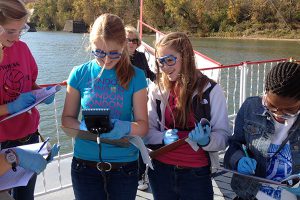
FORE offers two floating classroom program formats for high school students.
Riverboat Program
50 Student Maximum, $15/student with a $400 minimum to cover the boat rental fee*
During this program, students rotate through a variety of hands-on activities and labs at BB Riverboats in order to obtain a snap-shot of water quality in the Ohio River. Students assess water quality by performing water testing, and by studying aquatic organisms, including fish, plankton and macroinvertebrates.
Lunch: Students bring their own food and drink.
Pre-Voyage Classroom Presentation
The RiverREACH Floating Classroom curriculum includes a free pre-voyage classroom visit. This interactive presentation uses an EnviroScape® model to teach students about watersheds, non-point pollution and storm water runoff.
On-Board Activities
Water Sampling: Students will collect water samples from the bottom deck of the boat using VanDorne Samplers, plankton nets, and buckets. Students will visually check the clarity, temperature, and odor of the samples while discussing their observations at the sampling site.
Habitat Assessment: Students will compete in small teams to spot items on land or in the water. Items will include landmarks such as buildings, parks, and bridges; fish and macroinvertebrate habitat; birds and mammals; and point and non-point sources of pollution.
On Land Lab Activities
Water Chemistry: Students will use colorimetric tests to measure the “Big Three” parameters that are essential for aquatic life: temperature, dissolved oxygen and pH, and will learn how they relate to each other. They will also measure turbidity (water clarity) and nutrients as time allows in the schedule.
Ohio River Fish: In this activity, students work with real specimens of fish collected from the sampling site to learn about fish morphology and adaptations that allow fish to thrive in the river environment. Students also learn why fish are used as indicators of water quality.
Plankton: Students will conduct a plankton tow and study both phytoplankton (algae) and zooplankton from the river. They will also learn how plankton can be used as a water quality indicator.
Stream Quality Index: Students will process and examine macroinvertebrates collected from our sample site. They will work together to identify the macroinvertebrates they find and complete a Stream Quality Index.
Cruise Information and Registration
Canoe Program
30 Student Maximum, $15/student*
Lunch: Students bring their own food and drink.
The canoe variation of our RiverREACH floating classroom packs the same great water quality curriculum in an even more hands-on and intimate setting. Your students will receive an introduction to paddling safety, before embarking onto a local body of water in canoes. While on the water, we will start our water quality assessment with a habitat assessment, followed by collecting different types of samples and data to use in the grading of the body of water back on land in our traditional stations that cover plankton, chemistry, and fish. Just like the riverboat option, we offer a free in-class visit to introduce watershed science through a watershed model.
Cruise Information and Registration
*We do not want price to be a barrier to our programs, so offer a sliding scale based on your school’s free and reduced lunch rate. Occasionally, grants are available to help cover program costs as well.

